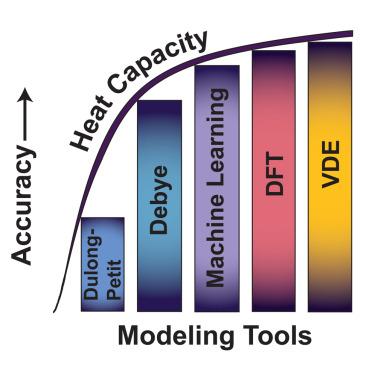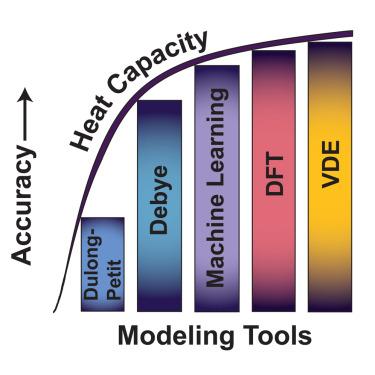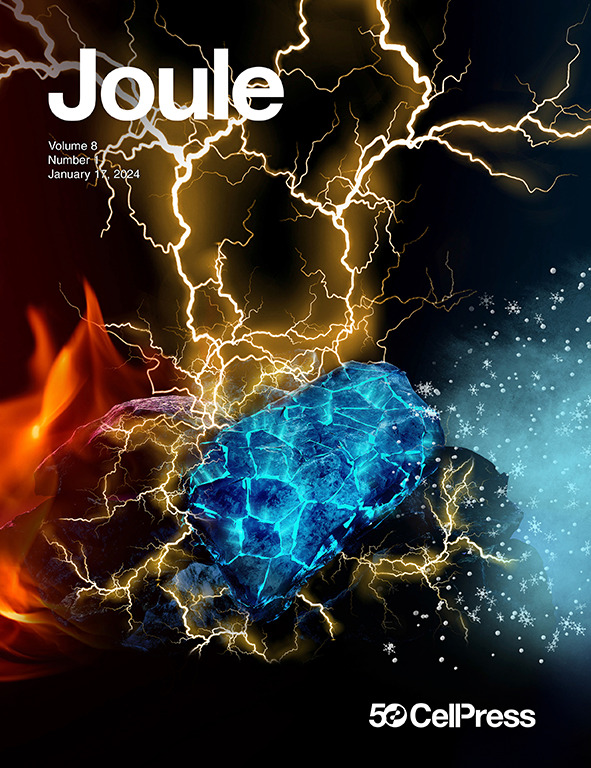能源技术中复杂材料的热容估算
IF 35.4
1区 材料科学
Q1 CHEMISTRY, PHYSICAL
引用次数: 0
摘要
热容是现代工程设计的基础,它直接关系到自由能变化和热输运。尽管目前的计算技术提供了原子振动的详细图像,但Debye和Dulong-Petit模型仍然被广泛使用,尽管精度较低。现代对振动状态、非谐性、电子载流子和相变的考虑可以改进估计。在这里,基于物理的振动+膨胀+电子(VDE)模型包含了用户提供的声子状态密度、声子压力膨胀项和电子组件。比较了分析、机器学习和第一性原理方法的声子态密度,从而突出了机器学习技术的优势。38种不同材料的热容估计通常在200至600 K之间的实验值的5%以内。详细的温度依赖性研究进行了几种材料,包括LiCoO2LiCoO2, ZIF-8, Mg3Sb2Mg3Sb2,聚氯乙烯(PVC)和非晶硅。通过其相变对Cu2Cu2Se进行建模,这进一步证明了模型支持工程设计和复杂分析的能力。本文章由计算机程序翻译,如有差异,请以英文原文为准。


Heat capacity estimation of complex materials for energy technologies
Heat capacity, which directly relates to free energy changes and thermal transport, is fundamental to modern engineering design. Even though current computational technology provides a detailed picture of atomic vibrations, the Debye and Dulong-Petit models are still widely utilized despite being prone to lower accuracy. Modern considerations of vibrational states, anharmonicity, electronic carriers, and phase transformations could improve estimates. Herein, the physics-based vibrational + dilation + electronic (VDE) model incorporates a user-provided phonon density of states, a phonon pressure-based dilation term, and an electronic component. Phonon density of states from analytical, machine-learned, and first-principles methods are compared, thus highlighting the advantages of machine-learned technology. Heat capacity estimates for 38 diverse materials are often within 5% of experimental values between 200 and 600 K. Detailed temperature-dependent investigations are carried out for several materials, including , ZIF-8, , polyvinyl chloride (PVC), and amorphous silicon. Se is modeled through its phase transition, which further demonstrates the model’s capabilities to enable engineering design and sophisticated analysis.
求助全文
通过发布文献求助,成功后即可免费获取论文全文。
去求助
来源期刊

Joule
Energy-General Energy
CiteScore
53.10
自引率
2.00%
发文量
198
期刊介绍:
Joule is a sister journal to Cell that focuses on research, analysis, and ideas related to sustainable energy. It aims to address the global challenge of the need for more sustainable energy solutions. Joule is a forward-looking journal that bridges disciplines and scales of energy research. It connects researchers and analysts working on scientific, technical, economic, policy, and social challenges related to sustainable energy. The journal covers a wide range of energy research, from fundamental laboratory studies on energy conversion and storage to global-level analysis. Joule aims to highlight and amplify the implications, challenges, and opportunities of novel energy research for different groups in the field.
 求助内容:
求助内容: 应助结果提醒方式:
应助结果提醒方式:


